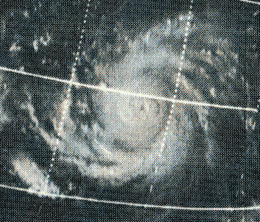Typhoon Patsy (1970)
Typhoon Patsy, known in the Philippines as Typhoon Yoling,[1] was the twenty-seventh named storm, twelfth typhoon, and seventh super typhoon of the 1970 Pacific typhoon season.[2]
| Typhoon (JMA scale) | |
|---|---|
| Category 4 super typhoon (SSHWS) | |
 Patsy with 110 mph winds on November 17 | |
| Formed | November 14, 1970 |
| Dissipated | November 22, 1970 |
| Highest winds | 10-minute sustained: 150 km/h (90 mph) 1-minute sustained: 250 km/h (155 mph) |
| Lowest pressure | 910 hPa (mbar); 26.87 inHg |
| Fatalities | 262+ direct |
| Damage | $80 million (1970 USD) |
| Areas affected | Philippines, Vietnam |
| Part of the 1970 Pacific typhoon season | |
On November 14, 1970, a tropical disturbance organized sufficiently to be designated a tropical depression. A steady intensification carried Tropical Storm Patsy's windspeeds up to 155 mph (250 km/h) and a minimum pressure of 918 mbar. It made landfall in Luzon with sustained winds of 130 mph (210 km/h) on November 19.[3] After emerging in the South China Sea, Patsy remained at tropical storm strength. It struck Vietnam during its Civil War as a weak tropical storm on November 22. The 8-day-old cyclone dissipated shortly after its final landfall.
US$80 million ($403 million in 2005) in damage was reported to have been caused by Patsy, though the total was likely higher. Deaths were officially reported to be 241, but an estimated 30 people unofficially died in Vietnam, raising the toll to 271+. An additional 351 people were reported missing. The total deaths and damage will likely be never known, as the Vietnam War was raging at the same time.
Meteorological history

A tropical disturbance was spotted south-southeast of Wake Island on November 10 close to the International Date Line and moved west. Warm waters and weakened shear allowed the storm to organize into Tropical Depression 27W on November 14 near the Marianas Islands. A strong ridge to its north forced it westward, where it strengthened to tropical storm status later on November 14, receiving the name Patsy.[2]
When Patsy was just barely above the threshold of tropical storm-strength, it slowed and passed just north of Saipan. Patsy continued to steadily intensify, reaching typhoon strength on November 16, 200 miles (322 km) northwest of Guam. The Western Pacific hurricane peaked at 155 mph (250 km/h) on November 18.[2]
Its inflow became disrupted by the Philippines to its west, and Patsy hit Luzon on November 19 with winds of 130 mph (210 km/h), making it the 3rd strong typhoon to strike the island since September and not to mention a direct hit over the National Capital Region of Metro Manila, then known as the Greater Manila area, with its center directly passing over it, and where many were caught unprepared. After crossing the island and weakening to a Category 2, Patsy traversed the South China Sea, where cooler waters kept the system from strengthening. This caused the cyclone to continue a weakening trend until it was downgraded to a tropical storm on November 20. On November 22, Patsy struck Vietnam as a 45 mph (70 km/h) tropical storm, and dissipated soon after.[2]
Impact
Deaths caused by Patsy reached 262 people, injured 1,756, and another 351[4] people were missing. Damage totals came in at US$80 million (US$403 million in 2005), mostly in the Philippines.
Philippines
Typhoon Patsy was one of the deadliest typhoons to strike the Philippines in its history. 106 people were killed (with 351 other missing) on the island, and 135 people were killed at sea from shipping failures. The USS President Taft was separated from its anchorage and collided with the Alikimon, a Greek vessel, while in Manila Bay. Another two ships were blown ashore in the Bay. On land, 31,380 of the refugees' homes were either destroyed or damaged.[2] The mass destruction caused in the Metro Manila National Capital Region, then known as the Greater Manila area, mainly by many being caught almost totally unprepared, destroyed many power lines and well into the next month were many areas in the metropolis still waiting for electric power to be restored.
Vietnam
In the South China sea off Vietnam's coast on November 2, an American ship, Army YFU-63, was fighting in the Vietnam War. It got caught in the bad weather from Patsy and capsized. At 10 am local time the next day, the ship was found and hauled ashore. All eleven men on board perished. One man was discovered dead near Cu Lao Island on November 6. Drowning was the cause of his death. Nine of the men were never discovered, but were considered to have died of drowning. The men were all posthumously promoted to a higher rank and families of the dead received a higher level pension. Seven years later on March 16, 1977, another body was recovered. In addition, two gunboats from the former country of South Vietnam sank the same day to the south of YFU 63's resting place. Death totals from them are not available.[5]
Records
Patsy was the deadliest tropical cyclone to strike Manila since the establishment of the Philippine Weather Bureau in 1865 until 2009 when Tropical Storm Ketsana (PAGASA Codename "Ondoy") affected the Philippine capital Manila, along with nearby provinces.[2]
External links
| Wikimedia Commons has media related to Typhoon Patsy (1970). |
References
- "PAGASA names, 1963–1988". Retrieved June 5, 2006.
- "Archived copy" (PDF). Archived from the original (PDF) on 2011-06-07. Retrieved 2011-06-07.CS1 maint: archived copy as title (link)
- "1970 Hurricane/Tropical Data for Western Pacific". Archived from the original on June 18, 2006. Retrieved July 8, 2006.
- nah7300.tmp Archived 2011-06-07 at the Wayback Machine
- Richard Dority, SGT, Army, Dover-Foxcroft ME, 04Nov71 02W060 - The Virtual Wall